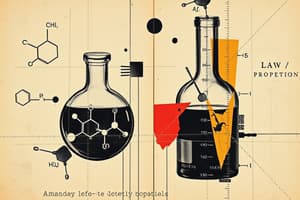Podcast
Questions and Answers
What is the primary role of the strong nuclear force within atomic nuclei?
What is the primary role of the strong nuclear force within atomic nuclei?
- It repels protons to maintain stability.
- It causes beta decay in neutrons.
- It provides the energy for electron orbits.
- It binds protons and neutrons together. (correct)
According to the Bohr model, what structure surrounds the nucleus of an atom?
According to the Bohr model, what structure surrounds the nucleus of an atom?
- Fixed, circular orbits of electrons. (correct)
- Random paths of electrons.
- A cloud of neutrons.
- A dense field of electric charge.
What key concept did Erwin Schrödinger introduce in the quantum model of the atom?
What key concept did Erwin Schrödinger introduce in the quantum model of the atom?
- Electrons have undefined energy levels.
- Electrons have fixed orbits around the nucleus.
- Electrons can be described using wave functions. (correct)
- Electrons exist only in particle form.
What notable property of neutrons did James Chadwick discover?
What notable property of neutrons did James Chadwick discover?
What is the approximate mass relationship between protons and electrons?
What is the approximate mass relationship between protons and electrons?
What is the definition of an isotope?
What is the definition of an isotope?
What does the mass number of an atom represent?
What does the mass number of an atom represent?
Which statement is true regarding cations and anions?
Which statement is true regarding cations and anions?
What characterizes a molecule?
What characterizes a molecule?
How is the average atomic mass of an element calculated?
How is the average atomic mass of an element calculated?
At what temperature are the readings on a Celsius thermometer and a Fahrenheit thermometer equal?
At what temperature are the readings on a Celsius thermometer and a Fahrenheit thermometer equal?
According to Dalton's Atomic Theory, which of the following statements is true?
According to Dalton's Atomic Theory, which of the following statements is true?
What is the specific gravity of a substance with a mass of 0.7 grams/mL?
What is the specific gravity of a substance with a mass of 0.7 grams/mL?
Which scientist is credited with publishing modern ideas about the nature of atoms?
Which scientist is credited with publishing modern ideas about the nature of atoms?
How many nanometers are in 3 angstroms?
How many nanometers are in 3 angstroms?
What does the Law of Definite Proportions state?
What does the Law of Definite Proportions state?
What was the outcome of Rutherford's Gold Foil Experiment?
What was the outcome of Rutherford's Gold Foil Experiment?
Which of the following best describes the electron based on Thomson's theory?
Which of the following best describes the electron based on Thomson's theory?
What does the Law of Multiple Proportions state?
What does the Law of Multiple Proportions state?
Which fundamental particle is discovered by J.J. Thomson?
Which fundamental particle is discovered by J.J. Thomson?
Study Notes
Atomic Theory
- Atoms are the fundamental building blocks of matter, existing on a nanoscale, originating from the Greek word "atomos".
- Democritus proposed that all matter is made of indivisible particles.
- John Dalton, often called the Father of Modern Atomic Theory, established the existence and nature of atoms based on experimental results in 1808.
- Dalton's Atomic Theory includes five main postulates about atoms and their combinations in compounds.
Relevant Laws
- Law of Definite Proportions states same compounds have constituent elements in fixed ratios.
- Law of Multiple Proportions indicates that when two elements combine to form different compounds, their mass ratios are small whole numbers.
Subatomic Particles
- Atoms consist of electrons, protons, and neutrons.
- J.J. Thomson discovered electrons in 1897 and proposed the Plum-Pudding Model.
- Ernest Rutherford's Gold Foil Experiment revealed that atoms are mostly empty space and contain a dense positive nucleus.
Proton and Neutron Details
- Protons are positively charged and have a mass approximately 1836 times that of electrons; they cannot escape the nucleus due to the strong nuclear force.
- Neutrons are electrically neutral, have a mass similar to protons, and were discovered by James Chadwick.
Atomic Structures
- Neils Bohr introduced the Planetary Model depicting electrons in fixed orbits around the nucleus in 1913.
- Erwin Schrödinger developed the Quantum Model, describing electrons via wave functions, reflecting their quantized energy levels.
Atomic Number and Isotopes
- Atomic Number indicates the number of protons in an atom's nucleus, while Mass Number is the sum of protons and neutrons.
- Isotopes are variants of elements with the same number of protons but differing in neutron count and atomic mass.
Molecules and Ions
- Molecules are stable entities formed by two or more atoms bonded together.
- Diatomic molecules consist of two atoms; polyatomic molecules have more than two.
- Ions are charged particles; cations have a positive charge, while anions have a negative charge.
Summary of Subatomic Particles
- Mass and charge of subatomic particles:
- Electrons: Very low mass, negative charge
- Protons: Significant mass, positive charge
- Neutrons: Similar mass to protons, no charge
Key Concepts in Chemistry for Engineers
- The relationship between the amount of work done and time defines power.
- The average atomic mass of an element is calculated using the mass and abundance of isotopes.
Sample Problems
- Understanding isotopes and calculating atomic mass based on different isotopic abundances is essential for practical applications in chemistry.
Studying That Suits You
Use AI to generate personalized quizzes and flashcards to suit your learning preferences.
Description
Test your knowledge on the Law of Definite Proportions and the Law of Multiple Proportions in chemistry. Understand how compounds are formed and the significance of atomic ratios in these laws. This quiz covers fundamental principles essential for chemistry students.




